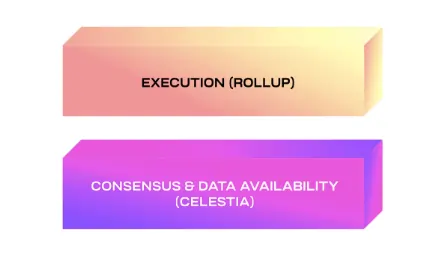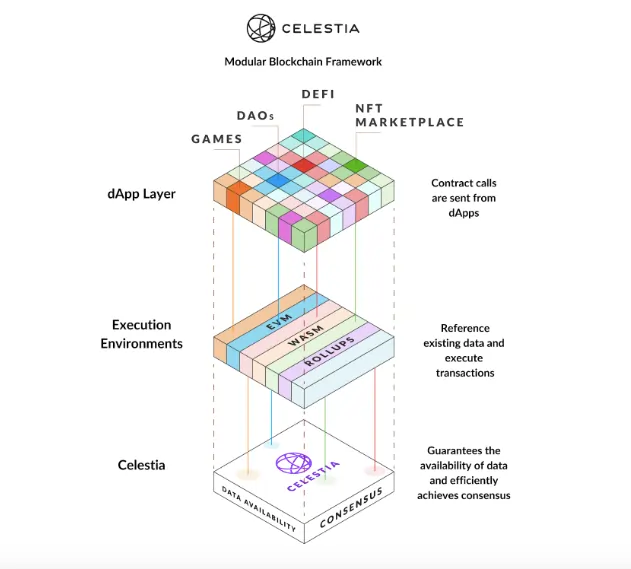A new paradigm:
What is the Celestia blockchain?
Celestia brings a new paradigm to Blockchain, and in this article we will answer: What is the Celestia blockchain.
Despite all of the progress made over the last few years, deploying a new blockchain can be a real hassle.
The Cosmos SDK has made significant progress in this area by offering a toolkit for developers to help launch customisable proof-of-stake blockchains that meet a specific project’s requirements. However, making your blockchain actually decentralised implies bootstrapping a wide set of independent validators willing to dedicate time and resources to secure your network, which represents a huge challenge for entrepreneurs who have many other competing priorities.
This is where the Celestia blockchain comes in.
Read what you need
Modular blockchains: a new paradigm
As of today, most blockchains we know are monolithic blockchains. This architecture implies that the two core functions of a blockchain, consensus and execution, occur at the same time and rely on the same set of validators. Due to this, scaling becomes challenging as each transaction requires execution by a full node, slowing down the process.
Let’s dive into a new concept : modular blockchains. As you probably have figured out by now, the whole point of the Celestia blockchain is to provide the consensus and data availability layers for dApps, letting developers only worry about their execution layer, or layer-2 rollup. An advantage of this modularity is that each application has its own execution space while inheriting the security of Celestia’s consensus.

Sovereign communities
With Celestia’s blockchain modularity, any application built on top of it can attain sovereignty and customizability with minimum setup. This means that developers and the community have the power to choose the appropriate execution environment, programming language, and decide to make updates to the app without hard forking the main chain. This level of flexibility empowers developers to focus on the core logic of their applications, while the Celestia blockchain takes care of the consensus, and ensures that every application’s data is accessible to anyone who requests it.

Users as first-class citizens of the network
Celestia also has an excellent feature that allows any user to run a light node at a low cost. This feature is aligned with the vision set by two of the founders, Mustafa Al-Bassam and Nick White, that everyone should be able to run a node and personally verify the network’s correct operation. This is made possible by Data Availability Sampling (DAS), a technology that enables a light node to verify a block with just a sample of its data, such as verifying a 100MB block with only 10KB of data. When performed across thousands of nodes, this probabilistic approach ensures that every data is available on the Celestia blockchain, thereby improving decentralisation by multiplying the number of nodes.
Thanks to DAS, even standard computers or smartphones can be light nodes, allowing app users to run their own nodes easily to access Celestia’s data and send transactions to consensus nodes. This technology allows every user to be a first-class citizen of the network, also permitting developers to rely less on third party nodes and helping decongest the network, improving scalability.
ZKValidator’s perspective
The Celestia project has been making significant progress lately, with the testnet having been operational since May 2022. An incentivized testnet will be launched this month in March 2023, and if all goes well, the mainnet will follow soon after. A strong ecosystem is already forming around Celestia, with several well known projects poised to integrate. We truly believe that Celestia will have a huge positive impact on mass adoption for blockchain technologies.
As one of the 100 validators selected from over 20,000 applicants (!), we at ZKValidator are thrilled to be part of this highly anticipated launch. We believe that Celestia will be a major step forward for roll-ups and modular chains, and look forward to supporting it through launch and beyond.
Learn more about Celestia and follow along with the progress towards mainnet launch:
How can I stake Celestia tokens?
Although it is not possible yet, you will very soon be able to stake your Celestia tokens with ZKValidator.
Conclusion
In summary, Celestia is a modular blockchain platform that offers sovereignty, customizability, and decentralization to its users. Its unique architecture allows developers to focus on their application’s core logic, while Celestia handles consensus and data availability layers. With Data Availability Sampling, even standard computers or smartphones can act as light nodes, giving every user the ability to be a first-class citizen of the network. Celestia’s launch is highly anticipated and expected to have a major positive impact on the mass adoption of blockchain technologies.
